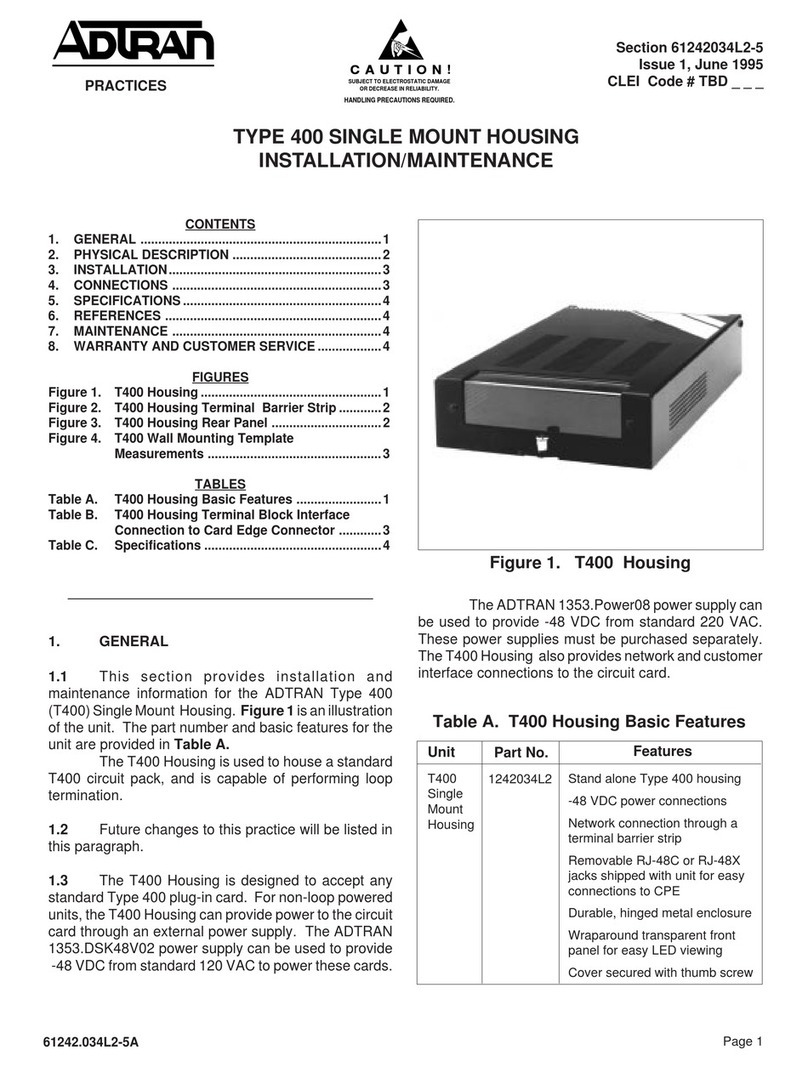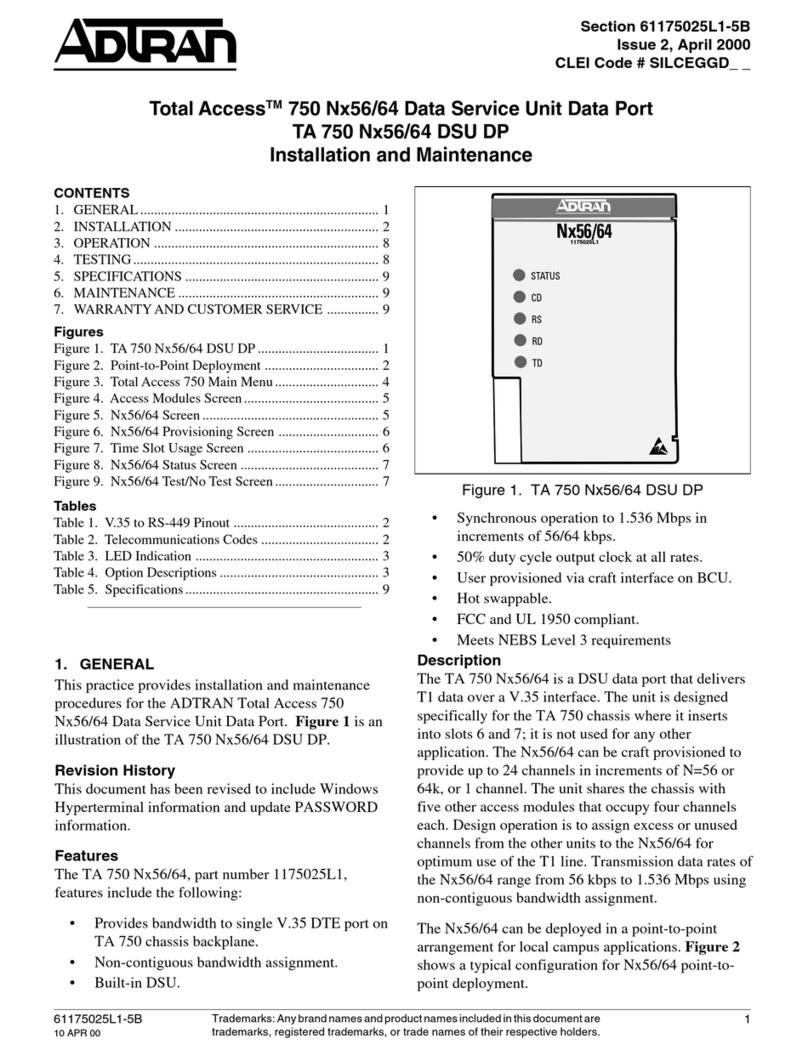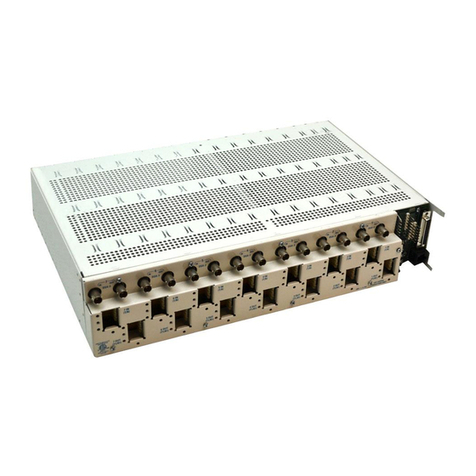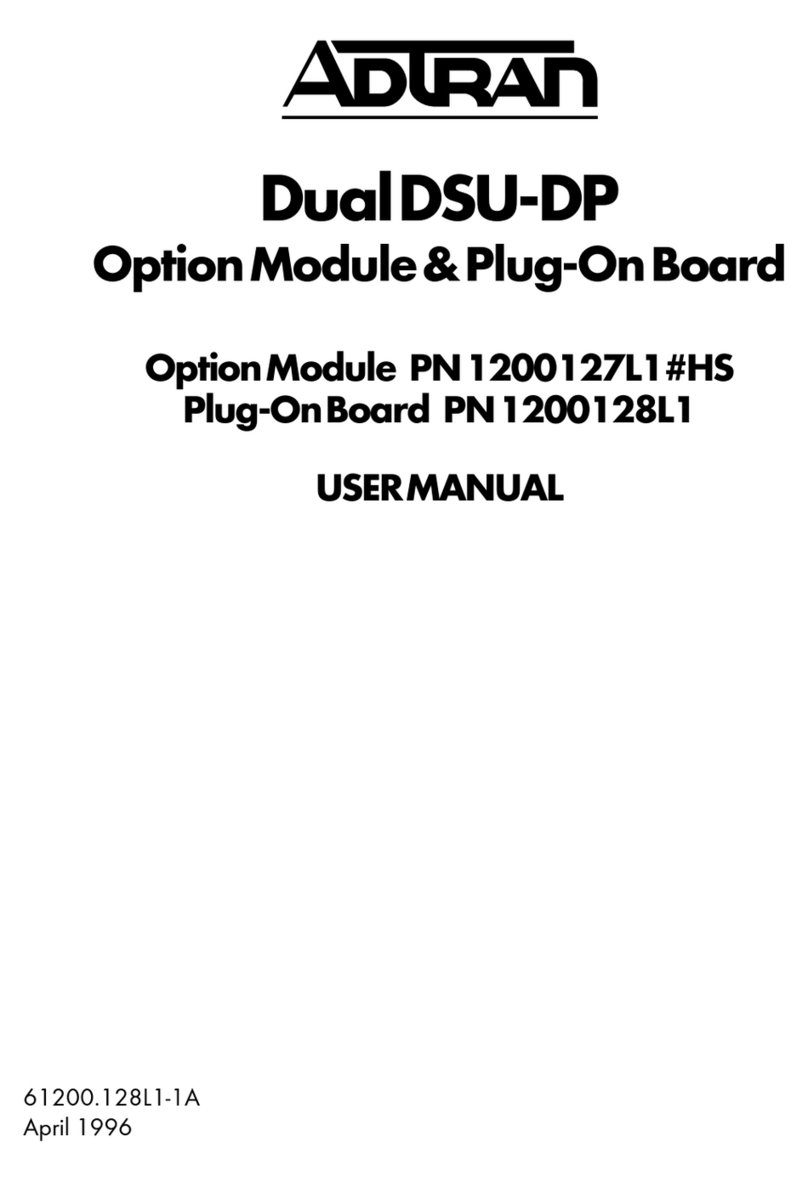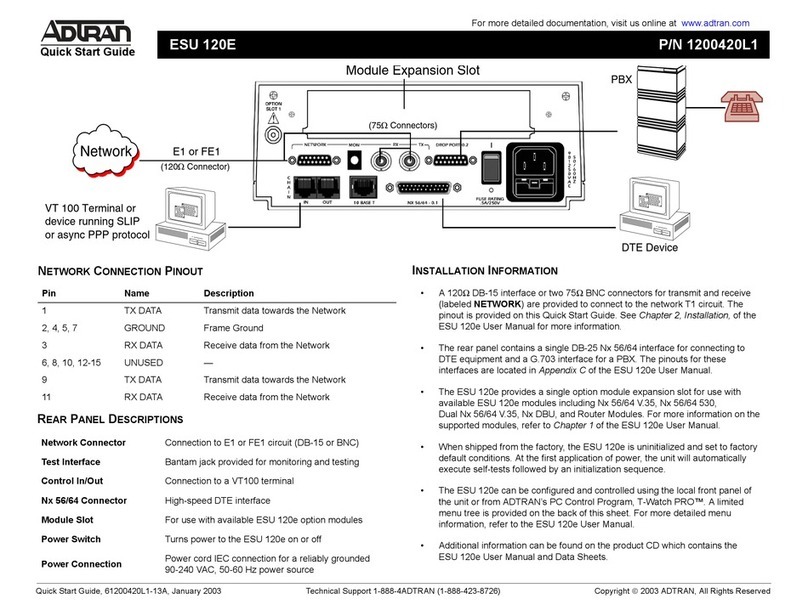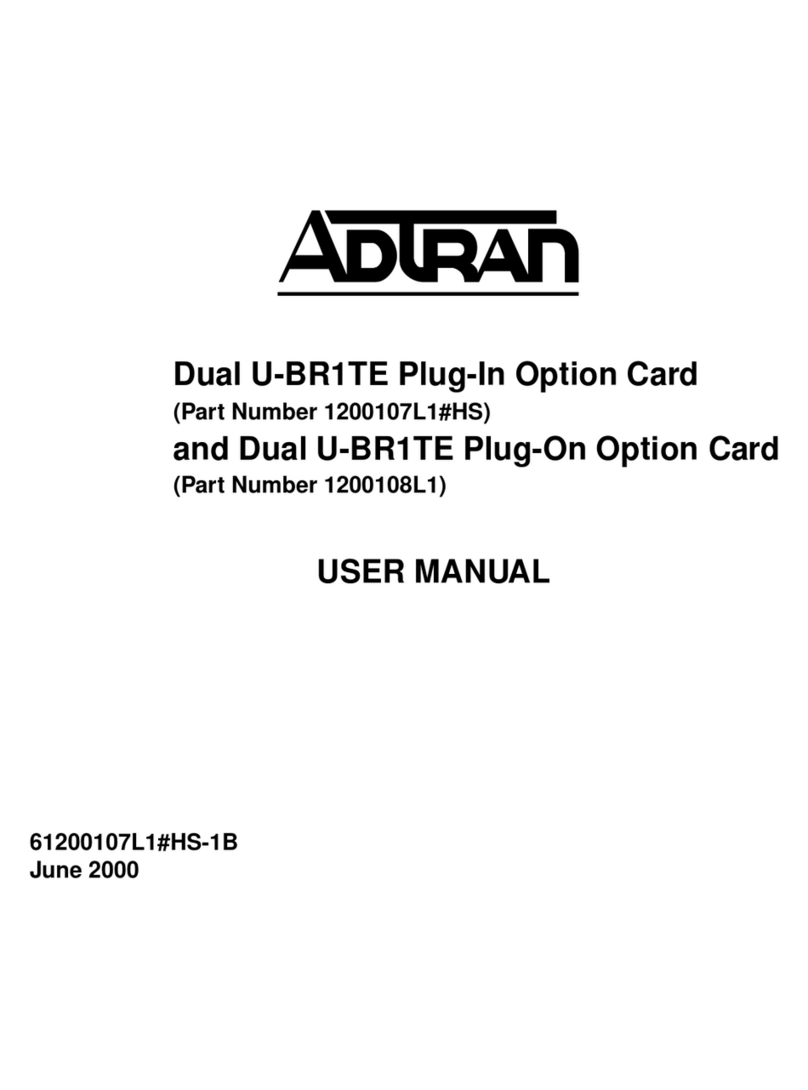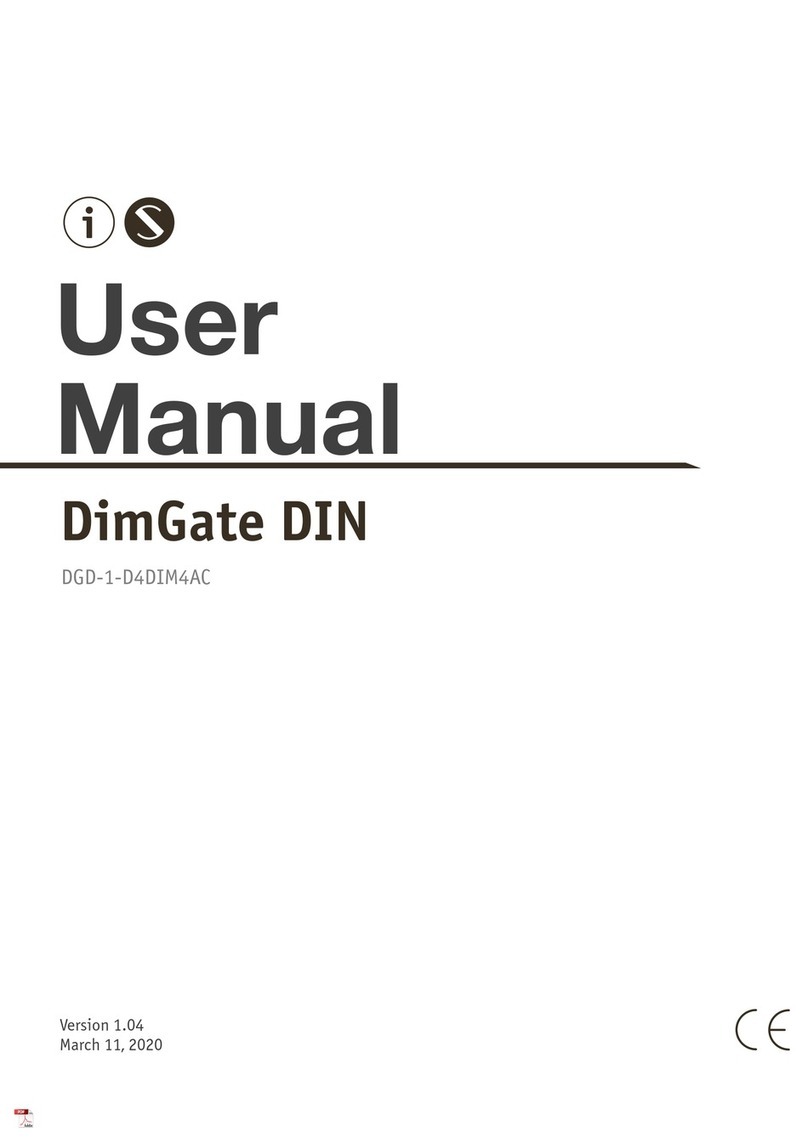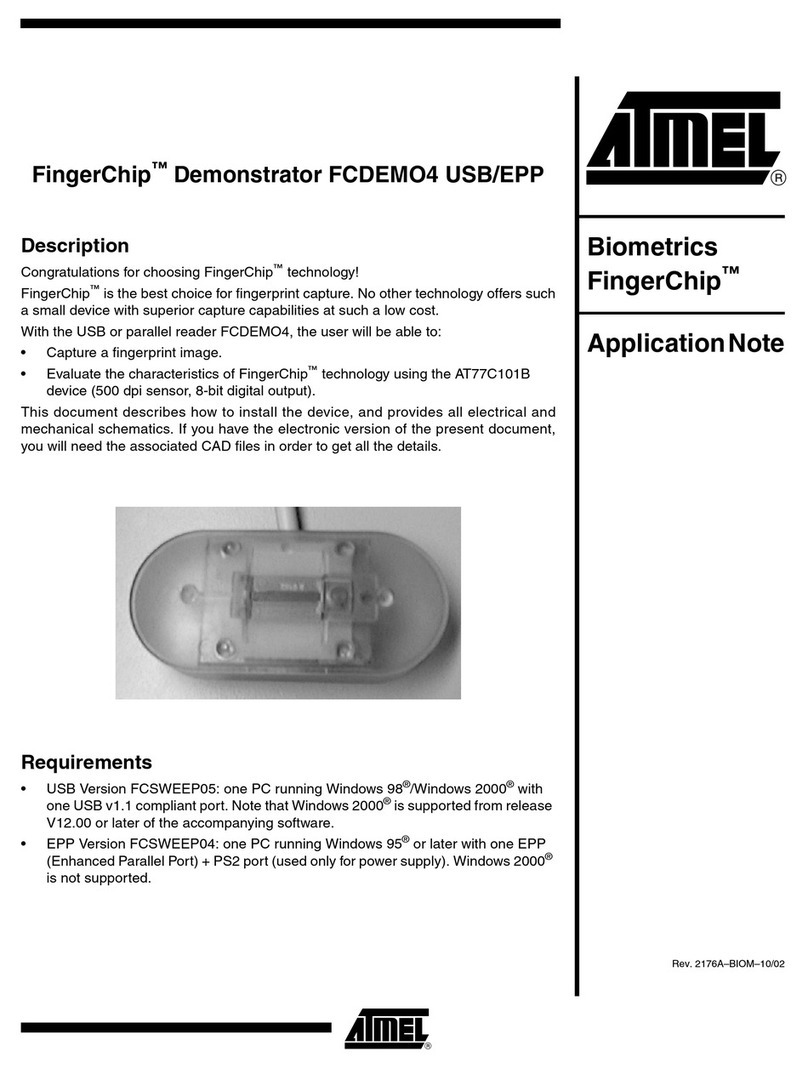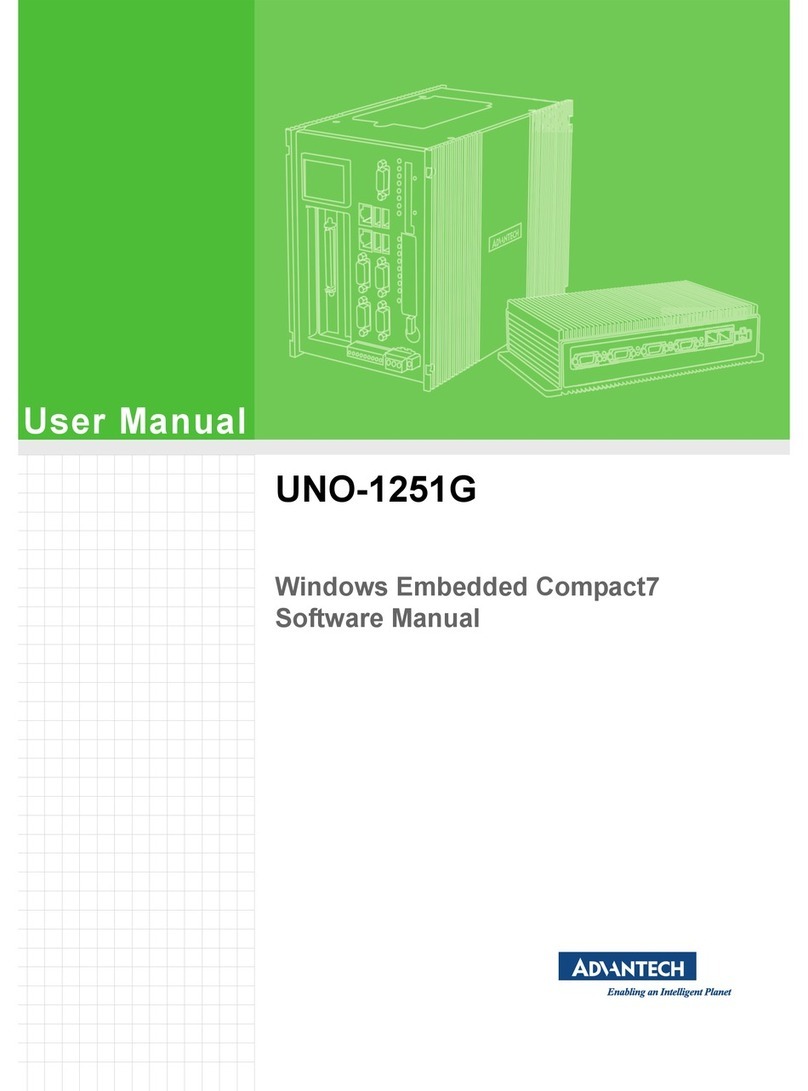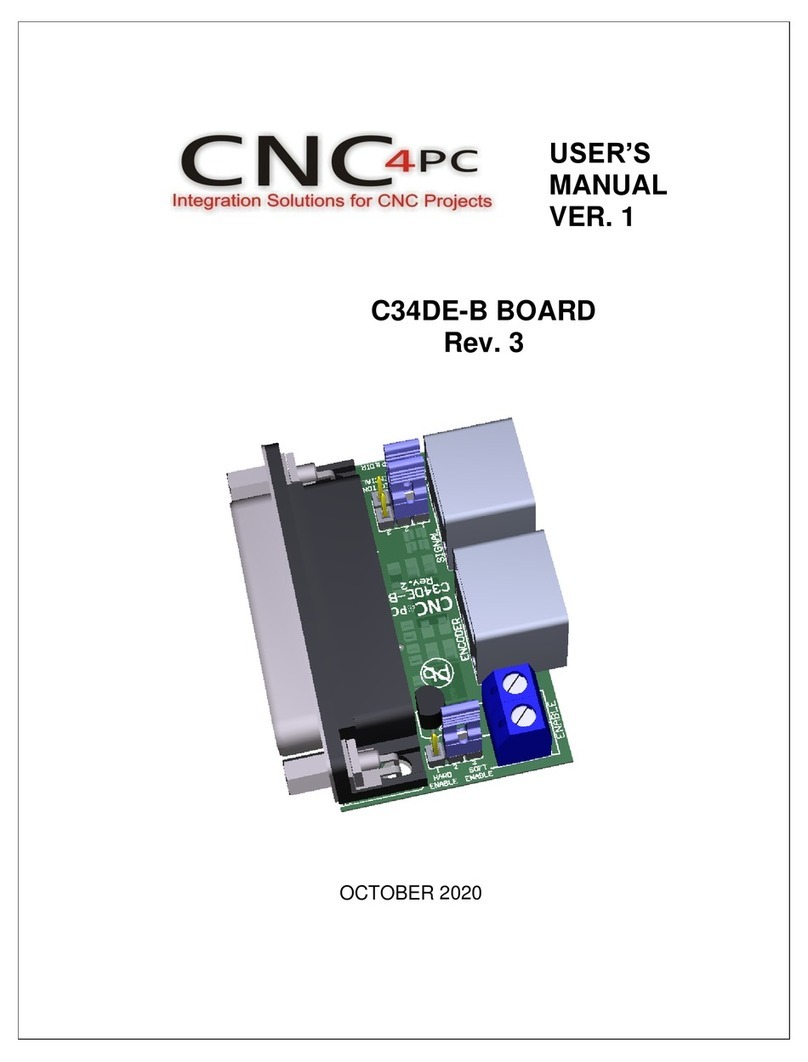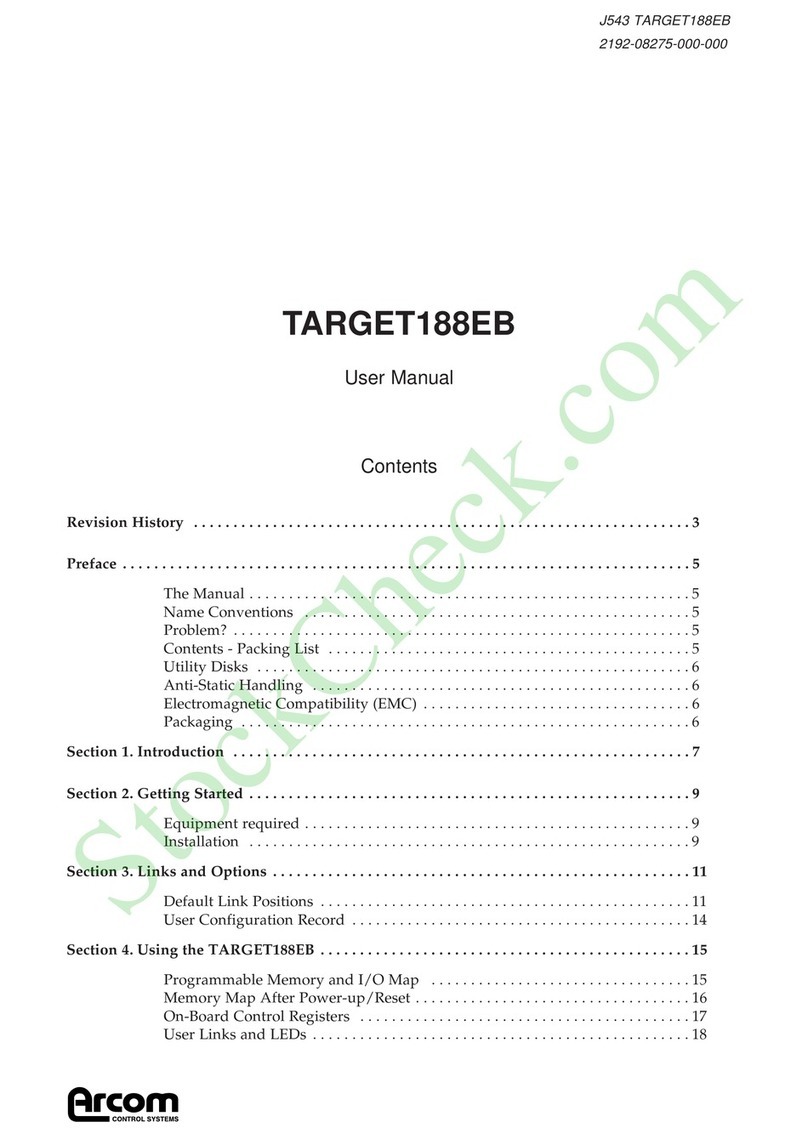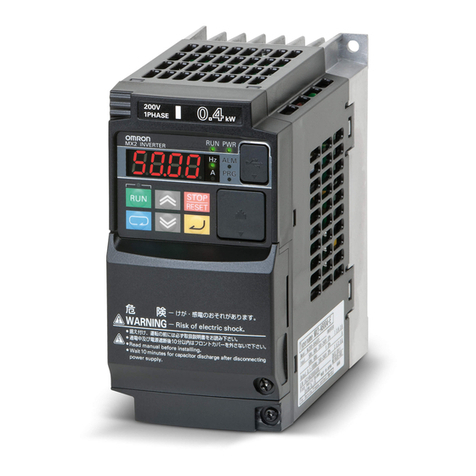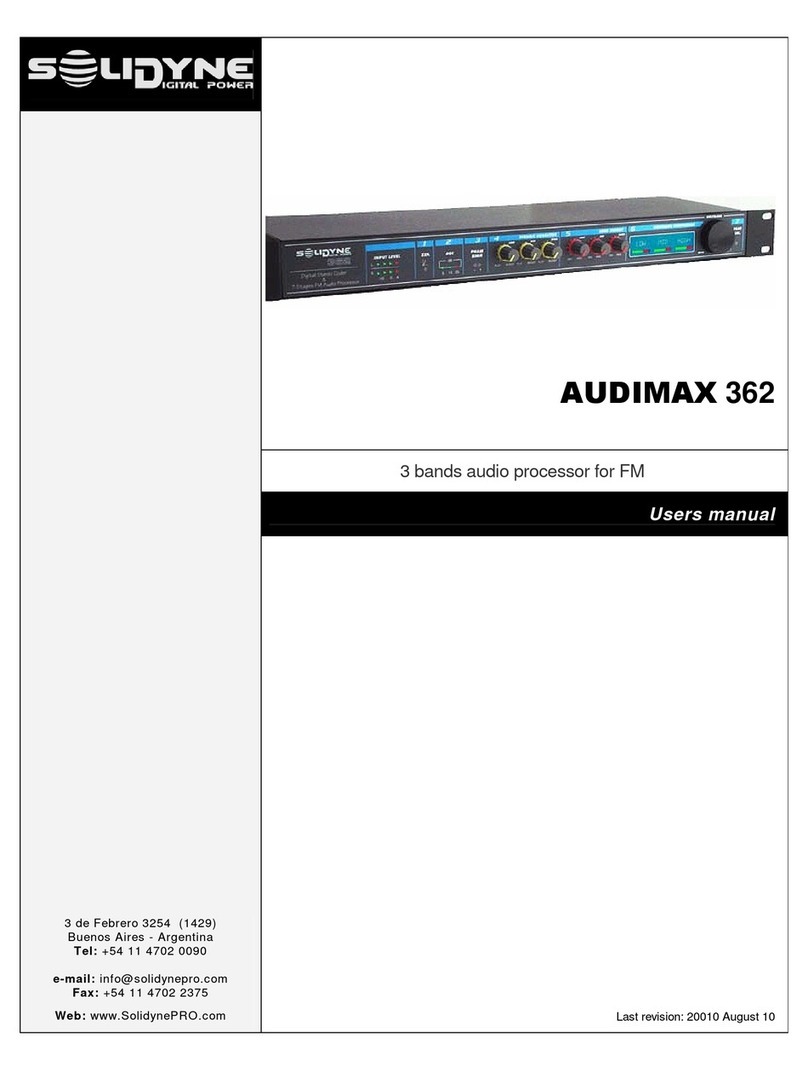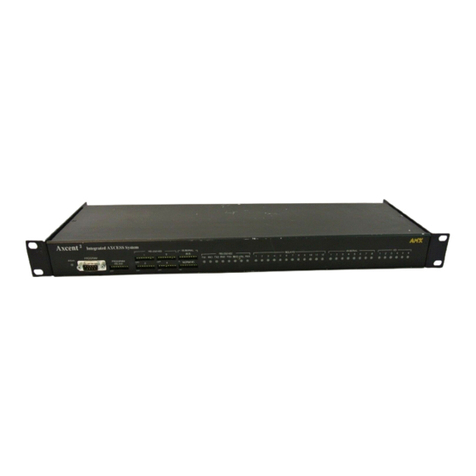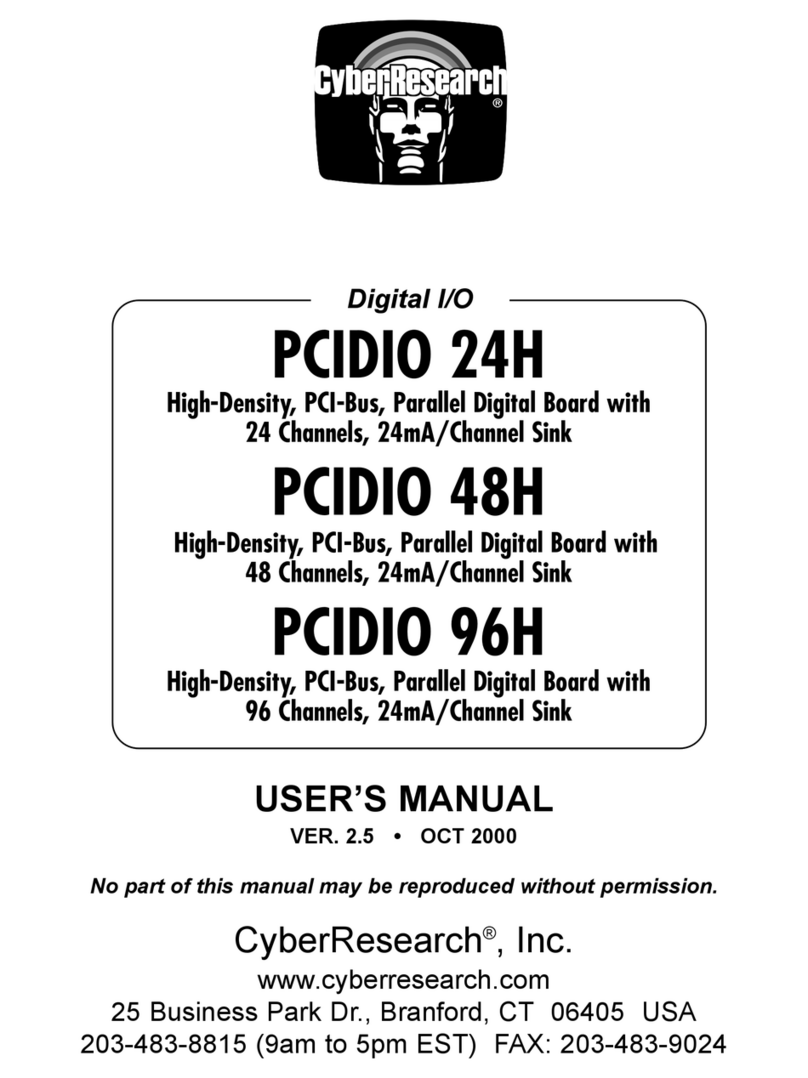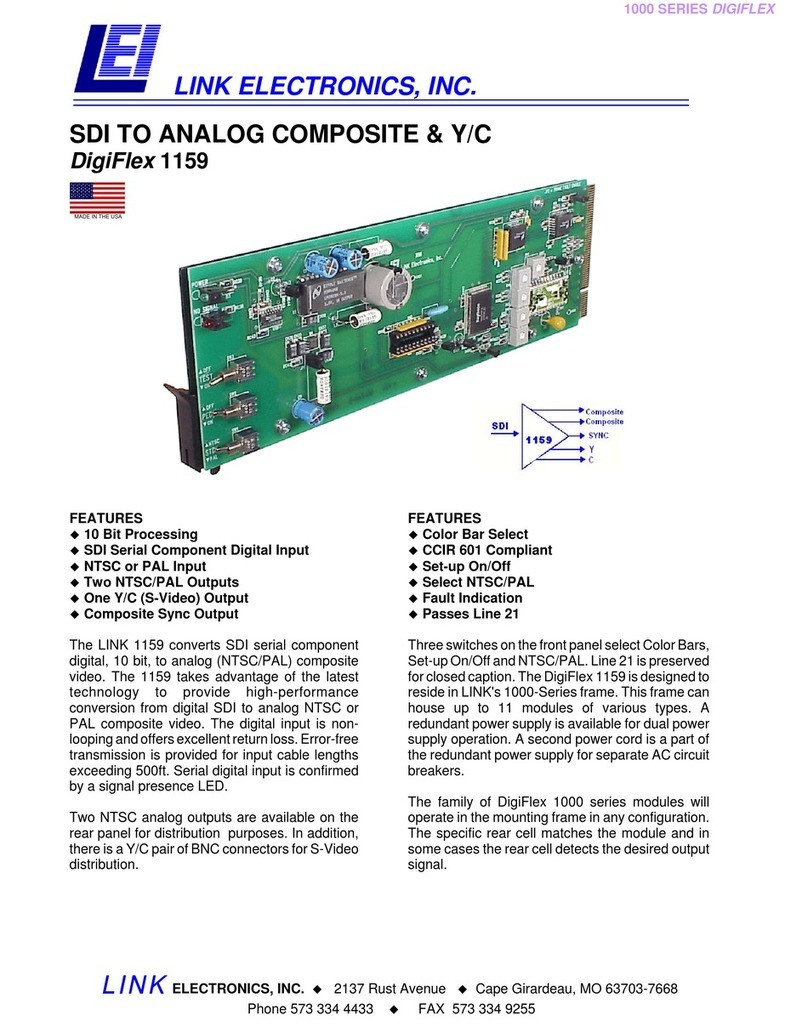ADTRAN AHT1U Maintenance and service guide

1Section 61245002L6-5, Issue 261245002L6-5C
Section 61245002L6-5C
Issue 3, February 2001
CLEI Code # SLL110XHAA
ADTRAN AHT1U
LOW VOLTAGE ASYNCHRONOUS HTU-C LINE CARD
FOR DSC COMMUNICATIONS CORPORATION
LITESPAN®CHANNEL BANK ASSEMBLIES
INSTALLATION/MAINTENANCE
CONTENTS
1. GENERAL ............................................................................ 1
2. APPLICATIONS .................................................................. 3
3. INSTALLATION.................................................................. 4
4. CONTROL PORT OPERATION......................................... 6
5. ALARMS ............................................................................ 13
6. HDSL DEPLOYMENT GUIDELINES ............................. 16
7. TROUBLESHOOTING PROCEDURES .......................... 17
8. MAINTENANCE ............................................................... 17
9. PRODUCT SPECIFICATIONS ......................................... 17
10. WARRANTY AND CUSTOMER SERVICE ................... 18
Appendix A. HDSL LOOPBACKS ......................................... A-1
FIGURES
Figure 1. ADTRAN AHT1U.................................................. 1
Figure 2. HTU-C Span Powering Diagram ........................... 3
Figure 3. Deployments from a Litespan Channel Bank
Assembly ................................................................ 3
Figure 4. HTU-C Card Edge Connections............................. 4
Figure 5. RS232 (DB9) Connector ........................................ 6
Figure 6. HDSL Main Menu Screen ...................................... 9
Figure 7. Current System Status, HRE Dual Loop Screen ... 9
Figure 8. Current System Status, Dual Loop Screen........... 10
Figure 9. HRE Performance History, Dual Loop Screen .... 10
Figure 10. Performance History, Dual Loop Screen ............. 11
Figure 11. ADTRAN Information, Dual Loop Screen .......... 11
Figure 12. Loopback Options, Dual Loop Screen ................. 12
Figure 13. Provisioning Screen .............................................. 12
Figure 14. Troubleshooting, Dual Loop Screen .................... 13
Figure 15. HDSL Deployment Guidelines ............................ 15
Figure A-1. HDSL Loopback Points...................................... A-1
Figure A-2. Element State Diagram ....................................... A-1
TABLES
Table A. Screen Abbreviations ................................................. 6
Table B. Provisioning Options ............................................... 14
Table C. LED Alarms ............................................................. 15
Table D. TL1 Alarm Conditions............................................. 15
Table E. HDSL Loss Values .................................................. 16
Table F. Loop Insertion Loss Data ........................................ 17
Table G. Worksheet PW-1 Replacements .............................. 17
Table H. Power Parameters for Replacements to
Worksheet PW-1 ...................................................... 17
Table I. Troubleshooting Guide ............................................ 18
Table J. ADTRAN AHT1U Specifications........................... 19
Table A-1. HDSL Loopback Control Codes ........................... A-2
Trademarks: Any brand names and product names included in this document are
trademarks, registered trademarks, or trade names of their respective holders.
1. GENERAL
The ADTRAN Low Voltage asynchronous Litespan
HDSL Transceiver Unit for the Central Office
(HTU-C) list 6, is a DS1 interface unit that provides
full T1 service over 4-wire interface facilities. The
Low Voltage Litespan HTU-Cs combine ADTRAN
HDSL technology and DSC Litespan technology to
provide an HDSL interface to a Litespan system.
ADTRAN’s Low Voltage Litespan HTU-C is
certified by DSC to safely operate in Litespan 2000
and Starspan systems. The unit is licensed under the
Asynchronous High-bit-rate Digital Subscriber Line
TI Interface Unit (AHT1U) channel unit type.
Figure␣ 1 is an illustration of the ADTRAN AHT1U.
Figure 1. ADTRAN AHT1U
HTU-C
1245002L6
AHT1U
R
S
2
3
2
LOOP
FAIL
HDSL
LP1 LP2

2Section 61245002L6-5, Issue 3 61245002L6-5C
Features
• RS-232 maintenance port
• Lightning and power cross-protection, static discharge
immunity, and local power bus fusing for line card
safety and protection
• 784␣ kbps dual duplex 2B1Q HDSL transmission over
two wire pairs
• Front panel status LED
• Performance monitoring and alarm reporting
• Low power consumption
• -135 volt span powering capability of the Low
Voltage HRE and HTU-R
• Corrosion-preventive sealing current over both
twisted copper pairs
• Troubleshooting functionality
Asynchronous counterparts to the Litespan HTU-C
(AHT1U) are the asynchronous DSX-1 interface unit
(ADS1U) and the asynchronous T1 interface unit
(AT1U). ADTRAN provides the AHT1U
(P/N␣ 1245002L6) for connection to narrowband and
wideband service pairs.
The List 6 provides the most flexibility for
installations where the narrowband/wideband service
connection is not known. It also provides flexibility
of switching between narrowband and wideband
services without needing a different HTU-C.
CAUTION
If the List 6 is used in applications where
narrowband and wideband copper service
wirepairsareconnectedsimultaneously,only
one service pair may have terminating
equipment connected to the HTU-C. Also,
copper service wire pairs not in use are
considered as bridge taps to the HDSL loops
in service and should be entered into the
deployment calculations listed in subsection
6ofthispractice. Ifthebridgedtapspresented
bytheunusedloopviolatestheCSAguidelines,
the unused pair should be disconnected.
Each ADTRAN Litespan HTU-C line card provides a
1.544␣ Mbps data transport over two unconditioned
CSA copper pairs that are in accordance with
TA-NWT-001210. These CSA loops can range up to
12␣ kft of 24-AWG twisted pair wire. All comply with
Bellcore GR1089-CORE, UL1459, FCC Class A
subpart␣ J, and DSC requirements for a generic
subscriber interface unit.
The Litespan HTU-C can be used in Litespan 2000,
Litespan 2012, and Litespan ONU channel bank
assembly (CBA) systems containing Litespan system
software versions of 7.1.3 or higher. Each HTU-C
works with the following multiple list versions of the
HDSL unit remote end (HTU-R), and HDSL Range
Extender (HRE):
• 1245024L1, Low Voltage T400 HTU-R
• 1245021L1, Low Voltage HTU-R T200 circuit pack
• 1245026L1 - L7, Low Voltage HTU-R T200, DB9
• 1244021L1, Low Voltage HTU-R T400 circuit pack
• 1244022L1, Low Voltage HTU-R standalone
• 1244041LX, Low Voltage T400 HRE
• 1244042L1, Low Voltage 819A HRE
• 1244044L1, Low Voltage 439 HRE
The HTU-C can be deployed in circuits consisting of one
HTU-C and one HTU-R. When deployment requires the
HRE, which doubles the service range, the HTU-C can
be deployed with one Low Voltage HRE (T400, 819A,
or 439) and one Low Voltage HTU-R.
The HDSL local loop operates as two independent
subsystems, each operating over a single twisted pair.
The HTU-C communicates over these two twisted
pairs to the HTU-R. Each subsystem carries half of
the total bandwidth along with a small amount of
overhead used for maintenance and performance
monitoring.
Lightning and power cross-protection is provided at
each twisted pair interface of the ADTRAN HTU-C
line card. Local power bus fusing is also used to
protect the Litespan channel bank backplane, Litespan
bank power supplies, and neighboring Litespan line
cards in the event of catastrophic line card failure.
The Litespan HTU-C uses a DC-to-DC converter to
derive span powering voltage from the Litespan
-48␣ VDC switched battery supply. The Litespan
HTU-C can span power HREs and HTU-Rs as listed
above.
Simplex current of 30 to 155 mA of current may be
coupled onto the HDSL loop span to power the
HTU-R and HRE when deployed (see Figure 2). Span
powering voltages meet all requirements of Class A2
voltages as specified by Bellcore GR-1089-CORE.
Revision History
This practice has been reissued to incorporate new
wording in the features subsection.

3Section 61245002L6-5, Issue 361245002L6-5C
Figure 2. HTU-C Span Powering Diagram
2B1Q
HDSL
SPAN POWER
REGULATOR SPAN CURRENT
T (3, 71)
R (4, 72)
T1 (5, 73)
R1 (6, 74)
LOOP 1
LOOP 2
Figure 3. Deployments from a Litespan Channel Bank Assembly
Common
Control
Channel Bank
Assembly with
a Litespan
HTU-C
Installed
HDSL Unit
Remote End
HDSL Loop Pairs
Litespan 2000 or 2012 System with Litespan HTU-C deployment
Common
Control
High-Density
Fiber Bank
ONU-96 with
an installed
Litespan HTU-C
OLNK
HDT
Typical Starspan System
HDSL Unit
Remote End
HDSL Loop Pairs
2. APPLICATIONS
The ADTRAN HDSL system provides a cost-effective
alternative for deploying T1 service over metallic
cable pairs. In contrast with traditional T1 service
equipment, ADTRAN HDSL can be successfully
deployed over two unconditioned, non-loaded,
bridged-tapped copper pair CSA loops (see subsection
6 of this practice).
Litespan HDSL deployment is typically made from a
Litespan 2000, Litespan 2012, or Litespan ONU
channel bank assembly. Figure 3 shows possible
ADTRAN HDSL deployments from a Litespan
channel bank assembly.
ADTRAN HDSL systems can be deployed quickly
without the use of expensive T1 repeater equipment
on standard CSA loops while using the existing
massive copper-fed twisted line pairs in use by the
industry.
ADTRAN uses negative ground-referenced span
powering voltage (-135 VDC) on HDSL loop 2 while
loop␣ 1 remains at ground. This prevents corrosion
associated with positive ground reference voltage
while providing power for the HTU-R. HTU-R span
powering can be disabled to allow locally-powered
HTU-R applications, if desired.
If normal CSA loops need expanding beyond the
maximum range of an HTU-C/HTU-R HDSL system,
a span-powered HRE can be added to effectively
double the HDSL serving area. Addition of a
span-powered HRE still allows span powering to be
passed through to a span-powered HTU-R, providing
a totally span-powered HDSL system. However,
addition of an HRE adds to the total power
consumption from the Litespan channel bank
assembly and requires recalculation of the power
budget deployment guidelines (see subsection 6).
HRE deployment may limit total Litespan linecard
deployment.

4Section 61245002L6-5, Issue 361245002L6-5C
3. INSTALLATION
After unpacking the unit, inspect it for possible
shipping damage. Make sure the desired Litespan
HTU-C list number appears at the top of the faceplate.
If damage is discovered, file a claim immediately with
the carrier, then contact ADTRAN Customer Service
(see subsection␣ 10 of this practice).
The Litespan HTU-C plugs directly into a Litespan
channel bank assembly channel unit slot. Litespan
system software must be 7.1.3, or higher. See Figure
4 for card edge connections.
Upon insertion of an HTU-C, the FAIL LED should
turn on immediately. The FAIL LED will remain on
until the Litespan bank recognizes the insertion of the
card and downloads the AHT1U channel unit type
code into the linecard. Typically, the FAIL LED will
remain on for approximately 15 to 20 seconds (time
may vary). Approximately 3 to 4 seconds after the
FAIL LED turns off, the HDSL LED will turn on red
and remain so until the HTU-C and HTU-R units
synchronize with each other over both HDSL loops.
CAUTION
Prior to installing or removing the Low
Voltage Litespan HTU-C, make sure to
observe the following warning:
If the Low Voltage Litespan HTU-C is
removed from a linecard slot, wait at least 15
secondsbeforereinsertion Ifconnectedtothe
MTI craft interface terminal, wait until the
message "AID:MJ,UEQ.."appears (where
“AID” is the access identifier). This informs
the Litespan common control assembly that
the HTU-C has been removed from its slot,
after which the common control assembly
begins looking for the reinsertion of the
linecard. Reinsertion any earlier than this
may temporarily lock the HTU-C into a
nonfunctional state because the common
control assembly will not send the AHT1U
equipment type code to the HTU-C linecard.
Figure 4. HTU-C Card Edge Connections
1
2
3
4
5
6
7
8
9
10
11
12
13
14
15
16
17
18
19
20
21
22
23
24
25
26
27
28
29
30
31
32
33
34
35
36
37
38
39
40
41
42
43
44
45
46
47
48
49
50
51
52
53
54
55
56
57
58
59
60
61
62
63
64
65
66
67
68
69
70
71
72
73
74
75
76
77
78
79
80
81
82
83
84
85
86
87
88
89
90
91
92
93
94
95
96
Frame Ground
Tip 1 Narrowband
Ring 1 Narrowband
Tip 2 Narrowband
Ring 2 Narrowband
Switch Battery (-48 VDC)
Positive Relay VCC (+5 VDC)
-5 VDC
Active A side signal
Logic and 5V system ground
A-side transmit circuit clock (4.096 MHz)
A-side receive circuit clock (4.096 MHz)
Logic and 5V system ground
A-side frame sync (1 kHz)
A-side receive data channel (8.192 MHz)
A-side transmit data channel (8192 MHz)
+5VDC (precharge pin)
Surge Ground
Frame Ground
Test Bus for Loop 1 (tip)
Test Bus for Loop 1 (ring)
Test Bus for Loop 2 (tip)
Test Bus for Loop 2 (ring)
Switch Battery Return (-48 VDC return)
-5 VDC
Active B side signal
Logic and 5V system ground
B-side transmit circuit clock (4.096 MHz)
B-side receive circuit clock (4.096 MHz)
Logic and 5V system ground
B-side frame sync (1 kHz)
B-side receive data channel (8.192 MHz)
B-side transmit data channel (8.192 MHz)
+5 VDC
Frame Ground
Tip 1 Wideband
Ring 1 Wideband
Tip 2 Wideband
Ring 2 Wideband
-5 VDC
T1 clock A-side (6.176 MHz)
Logic and 5V system ground
T1 clock B-side (6.176 MHz)
T1 frame sync A-side (8 kHz)
Logic and 5V system ground
T1 frame sync B-side (8 kHz)
+5 VDC
P1, Row A P1, Row B P1, Row C

5Section 61245002L6-5, Issue 361245002L6-5C
Provisioning
The Litespan HTU-C is provisioned in two steps.
First, local HTU-C provisioning is set using the
RS-232 port. Typical T1 provisioning options are set
for the Litespan HTU-C.
Second, Litespan system provisioning through a
Litespan craft interface port allows a data
cross-connection between the Litespan HTU-C and
another linecard in the asynchronous T1 linecard class
or another Litespan HTU-C. If the cross-connected
unit is not an HTU-C, then T1 provisioning of the
cross-connected unit may be accomplished through
the Litespan craft interface port. If the
cross-connected unit is another Litespan HTU-C,
however, provisioning of the cross-connected unit
must be performed at the front panel craft interface
port.
For complete Litespan cross-connection provisioning
information, refer to TL1 software documentation
release␣ 7.1, or higher.

6Section 61245002L6-5, Issue 361245002L6-5C
4. CONTROL PORT OPERATION
The Litespan HTU-C provides a faceplate-mounted
female DB9 connector that supplies an RS232
interface for connection to a controlling terminal. The
pinout of the DB9 is illustrated in Figure 5. The
linecard must be provisioned through the control port.
Switches or jumpers are not provided.
The terminal interface operates at data rates from
1.2␣ kbps to 19.2 kbps. The asynchronous data format
is fixed at 8 data bits, no parity and 1 stop bit. The
supported terminal type is VT-100 or compatible.
NOTE
If you are using a personal computer (PC)
with terminal emulation capability, be sure
to disable any power saving programs.
Otherwise, communication between the PC
andtheHDSLunitmaybedisrupted,resulting
in misplaced characters or screen timeouts.
For abbreviations used in the screen diagrams, see
Table␣ A.
Figure 5. RS232 (DB9) Connector
6
7
8
9
1
2
3
4
5
TXD (Transmit Data)
RXD (Receive Data)
SGN (Signal Ground)
Table A. Screen Abbreviations
Abbreviation
ES .......................
SES .....................
UAS ....................
SF........................
ESF .....................
B8ZS ...................
AMI ....................
LBO ....................
BPV ....................
NIU .....................
S/N ......................
15M ....................
24H .....................
Definition
Errored seconds
DSX/DS1
SF................ Second in which a BPV or frame bit error occurs
ESF ............. Second in which a BPV or CRC error occurs
HDSL.................. Second in which a CRC error occurs
Severely errored seconds
DSX/DS1
SF................ Second in which 1544 BPVs or 8 frame bit errors occur
ESF ............. Second in which 1544 BPVs or 320 CRC errors occur
HDSL.................. Second in which a 165 CRC error occurs
Unavailable seconds
DSX/DS1............ Second in which there is a loss of signal or sync
HDSL.................. Second in which there is a loss of signal or sync
Superframe format
Extended superframe format
Bipolar with 8-zero substitution
Alternate mark inversion
Line build-out
Bipolar violation
DSX/DS1 ............ Second in which a bipolar violation occurs
T1 Network Interface Unit
Serial number
Fifteen-minute period
Twenty-four-hour period

7Section 61245002L6-5, Issue 361245002L6-5C
The screens illustrated in Figures 6 through 14 are for
an HDSL circuit deployed with ADTRAN HDSL
technology. The circuit includes an HTU-C, HTU-R
and HRE for inclusiveness of functionality. Other
configurations are possible and their displays will vary
slightly from those shown in this section.
Initiate a terminal session by entering multiple space
bar characters; the number of which will determine
the speed of the terminal. Once the speed has been
determined, an Introductory Menu will appear.
From the Introductory Menu, the Main Menu may be
selected. The Main Menu provides access to detailed
performance and configuration information, as shown
in Figure 6, HDSL Main Menu Screen.
From the Main Menu, the following screens can be
accessed:
1. Current System Status
2. Performance History
3. ADTRAN Information
4. Loopback Options
5. Provisioning
6. Troubleshooting
Current System Status
The Current System Status screens, illustrated in
Figures 7 and 8, provide quick access to status
information for both the HTU-C and HTU-R. Type
“H” to view the Current System Status screen for the
HRE, illustrated in Figure 7.
The Elapsed Time display indicates the period of time
since the unit began collecting performance
information. At each 15-minute interval, the
performance information is transferred to the
15-minute performance data register accessed from
the Performance History screen. At each 24-hour
interval, the performance data is transferred into the
24-hour performance data register also accessed using
the Performance History screen.
At the Current System Status screen, type “Z” to reset
the performance registers to zero at both the Current
System Status and Performance History screens.
Figure 8 consolidates current information for the
HDSL, DSX-1, and DS1 interfaces. A key to the
information provided is found in the center of the
screen. Arrows indicate the key applies to both the
HTU-C and HTU-R.
LOSS ................. Pulse attenuation measurement
SYNC ................ HDSL loop 1 and loop 2 sync status
ES 15M/24H ..... Errored seconds 1
SES 15M/24H ... Severely errored seconds 1
UAS 15M/24H .. Unavailable seconds 1
An indication of pair reversal (if present) appears at
the bottom of the first key column. Status and
configuration information for the DS1 and DSX-1
signals is located in the center of the screen near the
bottom.
FRAME ...... T1 framing format selected
CODE ......... T1 line coded selected
LBO ............ Line build-out selected (for DSX-1),
Customer signal of 0 or -15 dB (for DS1)
NIU ............. Network interface unit enabled?
BPV ............ Bipolar violations detected (DSX1- and
DS1)
ES ............... Errored seconds (DSX1- and DS1)
SES ............. Severely errored seconds (DSX1- and
DS1)
UAS ............ Unavailable seconds (DSX1- and DS1)
Alarms ........ Lists current alarm condition status
A measure of signal quality for each HDSL loop is
displayed in graphic form on the bottom of the screen.
The measure is from 0 (poor signal quality) to 9
(excellent signal quality). Guidelines for interpreting
the indicators are as follows:
0 ......... Noise margin is ≤0 dB (≈10-7 BER)
1-8...... Margin measurement above 10-7 BER in dB
9 ......... Margin is ≥9 dB (excellent quality) above
10-7␣ BER
Predicting performance based upon signal quality
varies with each loop. Generally, a noise margin of 0
or higher will support a bit error rate (BER) of better
than 10-7.
1The first number is for the current 15-minute period and the second is the current 24-hour period (Loop 1 and Loop 2 numbers are
displayed).

8Section 61245002L6-5, Issue 361245002L6-5C
Performance Monitoring
The Performance History screen is shown in Figures 9
and 10. Type “H” to view the Performance History
screen for the HRE. See Figure 9 for the HRE
Performance Monitoring screen. Type “H” to select
the view number from the view location diagram
located at the lower left of the screen to see the
performance monitoring information collected at
every receiver location throughout the Low Voltage
HDSL system.
Once all performance monitoring locations have filled
up (after initial powerup), each successive
performance monitoring register update overrides the
oldest performance monitoring data. The current
performance monitoring registers are indicated by the
key at the center of the screen. Previous performance
monitoring registers are also indicated by the key at
the center of the screen. Each previous performance
monitoring register has a minus sign followed by a
number. A number “5” in the 24-hour register, for
example, represents 24-hour data from five 24-hour
periods ago. A number “2” in the 15-minute register
represents 15-minute data taken from two 15-minute
periods ago.
Loopback Options
The HDSL loopback screens are illustrated in Figure
12. Terminate or evoke loopbacks using these
screens. Refer to Appendix A for detailed HDSL
loopback information.
Control Port Provisioning
During a terminal session, type “5” from the Main
menu to view the Provisioning screen, illustrated in
Figure 13. This screen displays the current system
configuration and allows for changing this
configuration. Provisioning changes are only allowed
at the Litespan HTU-C and not at the HTU-R. The
HTU-R provisioning is set directly from the
provisioning information entered at the HTU-C. The
HTU-C stores its provisioning information in an
EEPROM so that it remembers the past provisioning
changes to determine its operating mode in the event
of power loss to the HTU-C.
Provisioning options 6 through 9 will not appear on
the HTU-R provisioning screen, and the alarm setting
provision on the HTU-R provisioning screen is
meaningless in a Litespan environment and should be
ignored.
DSX-1 in the HDSL screens actually refers to a virtual
DS1 channel provided by the time slot interchanger
unit (TSI) of the Litespan CBA to the Litespan
linecard (see DSC Litespan documentation for more
detail). The actual DSX-1 monitoring point is at the
T1 framer onboard the HTU-C linecard.
This monitoring point receives the DS1
cross-connected data recovered from the DS1 virtual
tributary presented to the linecard.
The asynchronous DS1 gate array on the HTU-C line
card is responsible for providing the DS1
cross-connected data that is recovered from the DS1
virtual tributary.
Provisioning options are summarized in Table B.
Each option may be changed to any one of the listed
settings.
Troubleshooting
The Troubleshooting screen, illustrated in Figure 14,
graphically depicts an HDSL circuit. The unit reviews
red, yellow, and blue alarm conditions in the circuit to
automatically predict where a fault is located. Once a
fault location is suspected, the corresponding portion
of the circuit on the screen is highlighted and a
message describing the failure will appear.

9Section 61245002L6-5, Issue 361245002L6-5C
Figure 6. HDSL Main Menu Screen
CIRCUIT ID: EMUL 10/06/98 00:25:00
ADTRAN HDSL MAIN MENU
1) CURRENT SYSTEM STATUS
2) PERFORMANCE HISTORY
3) ADTRAN INFORMATION
4) LOOPBACK OPTIONS
5) PROVISIONING
6) TROUBLESHOOTING
7) SET TIME/DATE/CIRCUIT ID
Choose a screen by pressing the corresponding number.
Figure 7. Current System Status, HRE Dual Loop Screen
CIRCUIT ID: XXX 10/06/98 09:22:14
LOOP #1 <NETWORK> LOOP #2 CURRENT SYSTEM STATUS LOOP #1 <CUSTOMER>LOOP #2
-------- HRE #1 -------- -------- HRE #1 --------
30(30) dB 31(31) dB <- LOSS CUR(MAX) -> 31(31) dB 30(30) dB
YES YES <- SYNC -> YES YES
000/00000 003/00003 <- ES 15M/24H -> 000/00000 000/00000
000/00000 000/00000 <- SES 15M/24H -> 000/00000 000/00000
000/00000 000/00000 <- UAS 15M/24H -> 000/00000 000/00000
LOOPBACK INACTIVE LOOPBACK INACTIVE
N = NETWORK SIDE RECEIVER
HRE1 NET MARGIN (dB) C = CUSTOMER SIDE RECEIVER HRE1 CST MARGIN (dB)
CUR/MIN/MAX CUR/MIN/MAX
____ ____ ____
LP1 12/00/00 |HTUC| LOOP1 |HRE1| LOOP1 |HTUR| LP1 13/00/00
LP2 13/00/00 | |========N| |C========| | LP2 16/00/00
| | | | | |
| |========N| |C========| |
|____| LOOP2 |____| LOOP2 |____|
Press “Z” to zero registers, “X” to restart MIN/MAX, “M” for Main Menu
“P” for previous view.

10Section 61245002L6-5, Issue 361245002L6-5C
Figure 8. Current System Status, Dual Loop Screen
Figure 9. HRE Performance History, Dual Loop Screen
CIRCUIT ID: XXX 10/06/98 09:23:09
24 HOUR REGISTERS PERFORMANCE HISTORY 15 MINUTE REGISTERS
---ES---SES--UAS— --ES-SES-UAS----ES-SES-UAS-
00000 00000 00000 <---CURRENT---> 000 000 000
10/05 ----- ----- ----- <-- --> 09:15 000 000 000 05:15 --- --- ---
10/04 ----- ----- ----- | | 09:00 --- --- --- 05:00 --- --- ---
10/03 ----- ----- ----- | | 08:45 --- --- --- 04:45 --- --- ---
10/02 ----- ----- ----- | | 08:30 --- --- --- 04:30 --- --- ---
10/01 ----- ----- ----- |PREVIOUS | 08:15 --- --- --- 04:15 --- --- ---
09/30 ----- ----- ----- | | 08:00 --- --- --- 04:00 --- --- ---
09/29 ----- ----- ----- <-- | 07:45 --- --- --- 03:45 --- --- ---
| 07:30 --- --- --- 03:30 --- --- ---
VIEW 1 : HRE NETWORK LP1 | 07:15 --- --- --- 03:15 --- --- ---
| 07:00 --- --- --- 03:00 --- --- ---
-->|H|<-----1->|H|<-2----->|H|--> | 06:45 --- --- --- 02:45 --- --- ---
|T| |R| |T| | 06:30 --- --- --- 02:30 --- --- ---
|U| |E| |U| | 06:15 --- --- --- 02:15 --- --- ---
<--|C|<-----3->|1|<-4----->|R|<-- | 06:00 --- --- --- 02:00 --- --- ---
| 05:45 --- --- --- 01:45 --- --- ---
Press view number to select view --> 05:30 --- --- --- 01:30 --- --- ---
Press “P” for previous view
Press “B” to go back 8 hours
Press “M” to return to the Main Menu
LOOP #1 <NETWORK> LOOP #2 CURRENT SYSTEM STATUS LOOP #1 <CUSTOMER>LOOP #2
--------- HTU-C --------- --------- HTU-R ---------
31(31) dB 30(30) dB <- LOSS CUR(MAX) -> 31(31) dB 31(31) dB
YES YES <- SYNC -> YES YES
000/00000 000/00000 <- ES 15M/24H -> 000/00000 000/00000
000/00000 000/00000 <- SES 15M/24H -> 000/00000 000/00000
000/00000 000/00000 <- UAS 15M/24H -> 000/00000 000/00000
LOOPBACKS INACTIVE LOOPBACKS INACTIVE
DSX-1 DS1
HTU-C MARGIN (dB) ------------------------------ HTU-R MARGIN (dB)
CUR/MIN/MAX ESF <- FRAME -> ESF CUR/MIN/MAX
B8ZS <- CODE -> B8ZS
LP1 11/09/12 N/A <- LBO -> 0 dB LP1 13/13/14
LP2 12/11/12 N/A <- NIU -> YES LP2 14/13/15
00000 <- BPV -> 00000
00000 <- ES -> 00000
00000 <- SES -> 00000
00000 <- UAS -> 00000
NONE <- ALARMS -> NONE
SEALING CURRENT PRESENT
Press “Z” to zero registers, “X” to restart MIN/MAX, “M” for Main Menu.

11Section 61245002L6-5, Issue 361245002L6-5C
Figure 10. Performance History, Dual Loop Screen
CIRCUIT ID: XXX 10/06/98 09:18:35
24 HOUR REGISTERS PERFORMANCE HISTORY 15 MINUTE REGISTERS
---ES---SES---UAS--- ---ES-SES-UAS-----ES--SES--UAS-
00000 00000 00000 <-- CURRENT --> 000 000 000
10/05 ----- ----- ----- <-- --> 09:15 000 000 000 05:15 --- --- ---
10/04 ----- ----- ----- | | 09:00 --- --- --- 05:00 --- --- ---
10/03 ----- ----- ----- | | 08:45 --- --- --- 04:45 --- --- ---
10/02 ----- ----- ----- | | 08:30 --- --- --- 04:30 --- --- ---
10/01 ----- ----- ----- |PREVIOUS | 08:15 --- --- --- 04:15 --- --- ---
09/30 ----- ----- ----- | | 08:00 --- --- --- 04:00 --- --- ---
09/29 ----- ----- ----- <-- | 07:45 --- --- --- 03:45 --- --- ---
| 07:30 --- --- --- 03:30 --- --- ---
VIEW 1 : HTU-C DSX-1 | 07:15 --- --- --- 03:15 --- --- ---
| 07:00 --- --- --- 03:00 --- --- ---
1->|H|<--3----LOOP1----4-->|H|--> | 06:45 --- --- --- 02:45 --- --- ---
|T| |T| | 06:30 --- --- --- 02:30 --- --- ---
|U| |U| | 06:15 --- --- --- 02:15 --- --- ---
<--|C|<--5----LOOP2----6-->|R|<--2 | 06:00 --- --- --- 02:00 --- --- ---
| 05:45 --- --- --- 01:45 --- --- ---
Press view number to select view --> 05:30 --- --- --- 01:30 --- --- ---
Press “B” to go back 8 hours
Press “M” to return to the Main Menu
Figure 11. ADTRAN Information, Dual Loop Screen
CIRCUIT ID: XXX 10/06/98 08:57:23
ADTRAN
901 Explorer Boulevard
Huntsville, Alabama 35806-2807
---------------------- For Information or Technical Support -------------------
Support Hours ( Normal 7am - 7pm CST, Emergency 7 days x 24 hours )
Phone: 800.726.8663 / 888.873.HDSL Fax: 256.963.6217 Internet: www.adtran.com
-------------------------------------------------------------------------------
HTU-C INFORMATION HTU-R INFORMATION
----------------- ------------------
S/N : S/N :
CLEI: CLEI:
MANF: / MANF:
Press “M” to view Main Menu.

12Section 61245002L6-5, Issue 361245002L6-5C
Figure 12. Loopback Options, Dual Loop Screen
CIRCUIT ID: XXX 10/06/98 09:23:42
LOOPBACK OPTIONS
_____ _____ _____
|HTU-C| |HRE 1| |HTU-R|
| | LP1 | | LP1 | |
--->|-----|<============>|-----|<============>|-----|<---
| | | | | |
NET | | | | | | CUST
| | LP2 | | LP2 | |
<---|-----|<============>|-----|<============>|-----|--->
| | | | | |
|_____| |_____| |_____|
1) LOOPBACK TO NETWORK AT HTU-C = INACTIVE
2) LOOPBACK TO CUSTOMER AT HTU-C = INACTIVE
3) LOOPBACK TO NETWORK AT HTU-R = INACTIVE
4) LOOPBACK TO CUSTOMER AT HTU-R = INACTIVE
5) LOOPBACK TO NETWORK AT HRE-1 = INACTIVE
6) LOOPBACK TO CUSTOMER AT HRE-1 = INACTIVE
Press corresponding number to toggle loopback option.
Press “M” to return to the Main Menu
Figure 13. Provisioning Screen
CIRCUIT ID: EMUL 10/06/98 00:23:50
PROVISIONING
A. DSX-1/DS1 LINE CODE = B8ZS
B. DSX-1/DS1 FRAMING = AUTO
* NIU LOOPBACK = ENABLED
C. NEW ENGLAND 1:6 LPBK = ENABLED
D. LOOPBACK TIMEOUT = NONE
E. CUSTOMER LOSS RESPONSE = AIS
F. LATCHING LOOPBACK MODE = T1
* PRM MODE = SPRM
* DS1 TX LEVEL = 0 dB
G. SPAN POWER = ENABLED
H. SINGLE LOOP OPERATION = DISABLED
I. SINGLE LOOP AIS = ENABLED
* Option not configurable from this terminal
Press: Option letter - to change option setting
Enter - to implement and save current setting changes
“M” - to return to the main menu

13Section 61245002L6-5, Issue 361245002L6-5C
5. ALARMS
Alarms are indicated by the Low Voltage Litespan
HTU-C in the following ways:
• HTU-C DB9 control port screen alarms
• Faceplate LEDs
• Standing alarms (through direct access to the
Litespan, or remote access through a modem
connection)
The HTU-C DB9 control port screen alarms are
presented on the Current System Status and
Troubleshooting screens. Red, yellow, and blue
alarms at both DSX-1 and DS1 interfaces plus HDSL
loop synchronization loss conditions are reported.
Table C defines faceplate LED alarm functions.
TL1 provides alarm support through TL1 retrieval of
standing alarms from the Litespan database. Table D
defines the TL1 alarm conditions.
Figure 14. Troubleshooting, Dual Loop Screen
CIRCUIT ID: XXX 10/06/98 09:22:41
TROUBLESHOOTING DISPLAY
_____ _____ _____
|HTU-C| |HRE 1| |HTU-R|
| | | | | |
| | | | | |
--->| |<=========>| |<=========>| |<---
| | | | | |
NET | | | | | | CUST
| | | | | |
<---| |<=========>| |<=========>| |--->
| | | | | |
| | | | | |
|_____| |_____| |_____|
NO ALARM CONDITIONS
Press “M” to return to the Main Menu

14Section 61245002L6-5, Issue 361245002L6-5C
Table B. Provisioning Options
(Default settings are indicated in bold typeface)
Option (Mode)
DSX-1/DS1 Line Coding (Code)
DSX-1/DS1 Framing (FRMG)
Loopback Timeout (LBTO)
DS1 Output Level (TXLV) 2
-135 VDC Span Powering (SPWR)
Single Loop Operation
Single Loop AIS
DS1 Latching Loopback
Customer LOS Response
Select
B8ZS ...................
AMI .....................
Auto ....................
ESF ......................
SF ........................
UNF .....................
FFFC 1.................
None ....................
60 minutes ...........
120 minutes ........
0 dB .....................
-15 dB ..................
Enabled...............
Disabled ..............
Enabled
Disabled ..............
Enabled...............
Disabled ..............
T1.........................
FT1 3....................
AIS ......................
LPBK ...................
CDI 4....................
Description
B8ZS line code enabled
AMI line code enabled
Unit automatically detects for SF or ESF framing
ESF framing enabled
SF framing enabled
No framing enabled
Forced Framing Format Conversion (ESF to SF)
No timeout of loopbacks is enabled
60-minute loopback enabled
120-minute loopback enabled
DS1 signal level delivered to customer is set at 0 dB
DS1 signal level delivered to customer is set at -15 dB
Enables the high voltage module onboard the HTU-C to provide -135␣ VDC of span
powering to connecting HDSL equipment
Disables -135 VDC span powering
Select Disabled for full T1 operation over both HDSL loops and alarm reporting for
both HDSL loops
AIS is provided to the network when only one HDSL loop is out of synchronization,
or when a signal loss is detected at the HTU-R T1 receiver. This blocks all T1 DS0s
while only one HDSL loop is out of synchronization. In HDSL applications involving
an HRE, an HDSL loop synchronization loss on any leg of the HDSL circuit will
cause AIS. In all HDSL applications, AIS will not be generated when a loopback to
the network is made at the HTU-C, HRE, or HTU-R. However, AIS will be
generated to the network with an HTU-C customer loopback.
AIS is provided to the network when both HDSL loops are out of synchronization, or
when a signal loss is detected at the HTU-R T1 receiver. This allows either DS0s 1
through 12 or 13 through 24 to be passed until full T1 bandwidth is restored. In HDSL
applications involving repeaters, AIS is provided to the network when an HDSL leg in
both loops are out of synchronization. In all HDSL applications, AIS will not be
generated when a loopback to the network is made at the HTU-C, HRE, or HTU-R.
However, AIS will be generated to the network with an HTU-C customer loopback.
When optioned for T1 mode, the unit does not respond to DDS Latching Loopback codes
DDS Latching Loopback operation is supported. The AHT1U and any HRE units which
are in the HDSL circuit are treated as Identical Tandem Dataports and the HTU-R is
treated as a different Tandem Dataport.
Send AIS to network upon T1 loss of signal or T1 AIS from customer
HTU-R initiates a network loopback upon T1 loss of signal or T1 AIS from customer
HTU-R send customer disconnect indication upon loss of signal or T1 AIS from customer
1The FFFC mode sets the HTU-C to ESF and the HTU-R to SF. This mode should be used to force SF (DS1 from customer) to ESF (DSX-1 to network)
conversion in the absence of network-provided ESF framing.
2This option is provisioned at the HTU-R.
3When operating in FT1 mode and during periods of T1 loss of signal, LOS, or T1 AIS from the customer CI, the HDSL system will send in the network
direction from the HTU-C a Fractional DS1 idle signal consisting of a repeating 7E (HEX) byte payload within a framed/unframed T1 signal. In
addition, when optioned for FT1 mode, the setting for Customer Loss Response is ignored.
4The CDI is generated by transmitting the framing received from the network while overwriting the payload with a repeating pattern. For applications
where the DS1 is Extended Superframe, the data link is overwritten with a Yellow Alarm that is interrupted once every second by a 100 milli-second
code burst of 7E (HEX).

15Section 61245002L6-5, Issue 361245002L6-5C
Table D. TL1 Alarm Conditions
TL1 Alarm
AID,T1:MJ,LOS,SA ..........
AID,EQPT:MJ,UEQ,SA ....
AID,EQPT:MJ,MEA,SA ...
AID,EQPT:MJ,FAIL,SA ...
TL1 Alarm Description
The access identifier (CBA slot) has a major
service-affecting alarm because of a loss of sync
condition on the HDSL loops or loss of signal at
the HTU-R DS1.
The access identifier (CBA slot) has a major
service-affecting alarm because no channel unit is
installed in an equipped CBA slot.
The access identifier (CBA slot) has a major
service-affecting alarm because of equipment
type mismatch.
The access identifier (CBA slot) has a major
service-affecting equipment failure.
Implications
There is an HDSL loss of sync in any HDSL leg, or
DS1 loss of signal at the HTU-R DS1 interface. The
HTU-C is in startup ,or a problem exists on the local
loop or customer interface.
No channel unit is installed in a slot which should
be equipped. The HTU-C is not inserted properly in
the correct slot, or the unit is defective.
The equipment installed in the channel bank slot
differs from the equipment type reserved in the
software record of the Litespan database. To clear
the alarm delete the equipment record (i.e.,
dlt-eqpt::cot-1-15 with TL1) and reinsert the card, or
equip the slot with the currently reserved equipment
type.
The Low Voltage Litespan HTU-C is unable to
operate normally or has failed a diagnostic test. See
subsection 10 of this practice.
AID is the access identifier (i.e., cot-1-15).
Table C. LED Alarms
Indicator Description
LOOP .................... Illuminates when a loopback to the network is in progress.
FAIL ...................... Illuminates upon HTU-C powerup. Remains On until the HTU-C is successfully initialized.
The length of time to complete this procedure is dependent on activity of the terminal control processor in the common control
assembly of the Litespan system.
Illuminates when the module is unable to operate as required.
HDSL .................... Initially Off. Upon successful powerup of the HTU-C linecard, and when the 6811 microcontroller on the HTU-C releases the
reset line internal to the linecard, the HDSL LED will illuminate Red to indicate that HDSL loops are out of synchronization.
When HDSL loops are synchronized between the HTU-C and HTU-R or HRE, the HDSL LED will change from Red to Yellow
or turn Off. In HRE applications, loop synchronization must be on both sides of the HRE.
A Yellow HDSL LED indicates that HDSL loops are both in synchronization, but a Yellow or Red alarm exists at the DS1
interface at the HTU-R.
When the HDSL LED is Off, both HDSL loops are in synchronization and no red or yellow alarm conditions exist at the HTU-R
DS1 interface.
LP1 ........................ Indicates five possible states of the quality of the HDSL signals on Loop 1:
Off ..........No synchronization of HTU-C and HTU-R on Loop 1
Yellow ....Marginal signal qauality on Loop 1 (>2 dB margin above 10 -7 BER)
Green.....Good signal quality on Loop 1 (>2 dB margin above 10 -7 BER)
Blinking ..An error detected on either end of Loop 1 will cause this LED to blink briefly
LP2 ........................ Indicates five possible states of the quality of the HDSL signals on Loop 2
Off ..........No synchronization of HTU-C and HTU-R on Loop 2
Yellow ....Marginal signal quality on Loop 2 (<2 dB margin above 10 -7 BER)
Green.....Good signal quality on Loop 2 (>2 dB margin above 10 -7 BER)
Blinking ..An error detected on either end of Loop 2 will cause this LED to blink briefly

16Section 61245002L6-5, Issue 361245002L6-5C
6. HDSL DEPLOYMENT GUIDELINES
The ADTRAN HDSL system is designed to provide
DS1-based services over loops designed to comply
with carrier service area (CSA) guidelines. CSA
deployment guidelines are given below.
1. All loops are non-loaded only.
2. For loops with 26-AWG cable, the maximum loop
length including bridged tap lengths is 9␣ kft.
3. For loops with 24-AWG cable, the maximum loop
length including bridged tap lengths is 12 kft.
4. Any single bridged tap is limited to 2 kft.
5. Total bridged tap length is limited to 2.5 kft.
6. The total length of multi-gauge cable containing
26-AWG cable must not exceed the following:
12 - {(3*L26)/9} - LBTAP (in kft)
L26 = total length of 26-AWG cable excluding
bridged taps (in kft)
LBTAP= total length of all bridged taps (in kft)
This deployment criteria is summarized in the chart
shown in Figure 15.
Figure 15. HDSL Deployment Guidelines
0
12
11
10
9
8
7
6
5
4
3
2
1
01234
WORKING LENGTH OF 26 GAUGE CABLE (KFT)
WORKING LENGTH OF 24 GAUGE (OR COARSER) CABLE (KFT)
56789
2.5
INVALID HDSL CABLE LENGTHS
2.0 1.5 1.0 0.5 0.0
TOTAL
BRIDGED
TAPLENGTH
(KFT)
VALID HDSL CABLE LENGTHS
Loop loss per kft for other wire is summarized in
Table E.
Recommended maximum local loop loss information
for PIC cable at 70°F, 135Ω, resistive termination is
provided in Table F.
An approximation for the maximum amount of
wideband noise on an HDSL local loop as measured
by a 50 kbps filter is ≤31 dBrn.
An approximation for the maximum level of impulse
noise as measured using a 50 kbps filter on an HDSL
loop is ≤50 dBrn.
NOTE
These approximations are to be used as
guidelines only and may vary slightly on
different loops. Adhering to the guidelines
should produce performance in excess of
10-7␣ BER.
Table F. Loop Insertion Loss Data
Frequency (Hz)
3000
10,000
50,000
100,000
150,000
196,000
200,000
Maximum Loss (dB)
12.0
15.0
25.5
30.0
32.75
35.00
35.25
Table E. HDSL Loss Values
(200 kHz cable loss in dB/kft at 135Ω)
Cable Gauge
26
26
24
24
22
22
19
19
Cable Type
PIC
Pulp
PIC
Pulp
PIC
Pulp
PIC
Pulp
Temperature
68°90°120°
3.902 4.051 4.253
4.030 4.179 4.381
2.863 2.957 3.083
3.159 3.257 3.391
2.198 2.255 2.333
2.483 2.450 2.629
1.551 1.587 1.634
1.817 1.856 1.909

17Section 61245002L6-5, Issue 361245002L6-5C
Table G. Worksheet PW-1 Replacements
When deploying any of the Low Voltage Litespan
HTU-Cs, the power requirements for the application
should also be considered for product mix
calculations and maximum number of low Voltage
Litespan HTU-Cs within a channel bank assembly.
Use Worksheet PW-1 in the Engineering and
planning section of DSC practice, OSP TL1 software
documentation release 7.1, or higher to determine
whether a particular combination of channel units is
within power-drain specifications. When using
ADTRAN Low Voltage Litespan HTU-C, use the
replacement factors listed in Table K instead of the
ones listed in Worksheet PW-1. The power
parameters shown in Table H are for four
configurations listed in Table G. These values are
derived from an HDSL system with worst-case power
measurements.
7. TROUBLESHOOTING PROCEDURES
Table I is a troubleshooting guide for the Low Voltage
Litespan HTU-C.
8. MAINTENANCE
The ADTRAN Low Voltage Litespan HTU-C requires
no routine maintenance.
ADTRAN does not recommend that repairs be
performed in the field. Repair services may be
obtained by returning the defective unit to the
ADTRAN Customer Service RMA department (see
subsection 11 of this practice).
9. PRODUCT SPECIFICATIONS
Product specifications are listed in Table J.
Configuration
Original Worksheet PW-1 values for AHT1U with no repeater
and a span-powered HTU-R.
Do not use original worksheet values with
ADTRAN products.
ADTRAN Low Voltage Litespan HTU-C and an HTU-R, P/N
1245021L1 or 1245026L1.
ADTRAN Low Voltage Litespan HTU-C with an HRE P/N
1244041 or 1244042, and an HTU-R P/N 1245021L1 or
1245026L1.
A Column Factor B Column Factor C Column Factor
0.430 0.076 0.200
0.525 0 0.120
1.525 0 0.225
Table H. Power Parameters for Replacements to Worksheet PW-1
(all worst-case HDSL loop power measurements)
Power Bus
+5V
-5V
-48V switch battery
-48V talk battery
Power consumption
Power Dissipation
ADTRAN Low Voltage Litespan
HTU-C and a Low-Voltage HTU-R,
P/N 1245021 or 1245026L1
525 mA
0 mA
120 mA
0 mA
8.4 watts
3.86 watts
ADTRAN Low Voltage Litespan HTU-C with
an HRE P/N 1244041L2 or 1244042L1, and
an HTU-R P/N 1245021L1 or 12450026L1
525 mA
0 mA
255 mA
0 mA
14.9 watts
4.61 watts

18Section 61245002L6-5, Issue 361245002L6-5C
10. WARRANTY AND CUSTOMER SERVICE
ADTRAN will replace or repair this product within
ten years from the date of shipment if it does not meet
its published specifications or fails while in service
(see ADTRAN Equipment Warranty, Repair, and
Return Policy and Procedure).
Return Material Authorization (RMA) is required
prior to returning equipment to ADTRAN.
Table I. Troubleshooting Guide
Condition
At powerup, all front panel
indicators are off.
The FAIL LED remains on.
The FAIL LED is off, but the
HDSL LED remains red.
The FAIL LED is off, but the
HDSL LED remains yellow.
Solution
1. Verify that the channel bank or ONU BPS power LEDs are on.
2. Make sure that the unit is fully and correctly inserted into the channel bank or ONU.
3. If step 1 fails, contact DSC customer service (see subsection 10 of this practice). If step 1
passes, but step 2 fails, replace the HTU-C.
1. Verify that the channel bank or ONU BPS FAIL LEDs are off.
2. Verify that the equipment type for the Litespan HTU-C slot is AHT1U. Using TL1,
equipment type is shown with the command rtrv-eqpt::AID, where AID is the access
identifier (i.e., cot-1-15).
3. If step 1 fails, contact DSC customer service (see subsection 10). If step 1 and step 2 pass,
replace the HTU-C. If step 1 passes but step 2 fails, delete the equipment record
(i.e.,␣ dlt-eqpt::cot-1-15 with TL1) and reinsert the card, or equip the slot with the
currently reserved equipment type.
1. Check that neither HDSL loop is open.
2. Check that neither or both HDSL lops are shorted.
3. Verify the loop conforms to CSA guidelines and is not too long. Loop loss at 200 kHz
should be less than 35.25 dB.
4. Verify that both HDSL loops have acceptable noise limits (see subsection 6).
5. Verify that tip and ring of each HDSL loop belongs to the same twisted pair.
6. If steps 1 through 5 pass, but the HDSL LED remains red, replace the HTU-C.
7. If step 6 fails, replace the HTU-R and the HRE.
1. Check that the framing and line coding are set appropriately for T1 data at the HTU-R and
for cross-connected T1 data coming to the HTU-C
2. Check that the DS1 LED at the HTU-R is green.
3. If step 1 fails, change the appropriate framing and line coding (see Control Port
Provisioning). If step 1 passes, but step 2 fails, a problem may exist at the HTU-R T1
interface. If the problem does not exist at the T1 interface, replace the HTU-C.
For service, RMA requests, or further information,
contact one of the following numbers.
ADTRAN Customer Service:
ADTRAN Telco Technical Support ........ (800) 726-8663
Standard support hours............................. Monday-Friday
7 a.m. - 7 p.m. CST
Emergency support..................7 days/week, 24 hours/day
Sales.......................................................... (800) 827-0807
RMA (repair service) ............................... (256) 963-8722
Repair and Return Address:
ADTRAN, Inc.
Customer and Product Support (CAPS) Department
901 Explorer Boulevard
Huntsville, Alabama 35806-2807

19Section 61245002L6-5, Issue 361245002L6-5C
Table J. ADTRAN AHT1U Specifications
Loop Interface
Modulation Type ..................................... 2B1Q
Mode........................................................ Full duplex, echo cancelling
Number of pairs ...................................... Two, with connections to narrowband and wideband
Bit Rate.................................................... 784 kbps per pair
Baud Rate ................................................ 392 baud per pair
Service range ........................................... Defined by CSA guidelines
Loop Loss ................................................ 36 dB maximum @ 200 kHz
Bridged Taps ........................................... Single Taps < 2 kft, total taps ≤2.5 kft
Performance ............................................ Compliant with Bellcore TA-NWT-001210
HDSL Tx Signal Level ........................... 13.5 dBm
Input Impedance...................................... 135Ω
Return Loss ............................................. 20 dB (40 kHz to 200 kHz)
Power
Power Consumption .................................................. +5V: 2.7 watts typical; 48V (see Table H). Includes HTU-C, HTU-R, and with
or without and HRE
Maximum Power Dissipation with an HRE ............. < 8.5 watts (see Table H)
Span Power................................................................ -135 VDC internally generated from the -48 VDC switch battery
Fusing ........................................................................ -48 VDC (switch battery) is current-limited by a 500 mA Slo-Blo® subminiature
surface-mount fuse. +5 VDC is current-limited by a 3A quick-acting
subminiature surface-mount fuse.
Clock
Clock Sources ......................................... Internal, DSX-1 derived
Internal Clock Accuracy ......................... ±25 ppm, (exceeds Stratum 4). Meets T1.101 timing requirements
Tests
Diagnostics .............................................. Local loopback (HTU-C), remote loopback (HTU-R), troubleshooting screen
Physical
Mounting ................................................. Litespan 2000 CBA, Litespan 2012 CBA, or an ONU CBA
Dimensions .............................................. 4.42" high x 0.84" wide x 10.4" deep (11.22 cm x 2.13 cm x 26.4 cm)
Weight ..................................................... Less than one pound
Environment
Temperature ............................................ Operating (standard): -40°C to +70°C, Storage: -40°C to 85°C
Humidity ................................................. Up to 95% noncondensing
Electrical/Safety Protection .................... Complies with Bellcore GR1089-CORE, UL1459, FCC Class A subpart J, and DSC
requirements for a generic subscriber interface unit.
Control Port
Interface................................................... RS232 (DB9)
Terminal Type ......................................... VT 100, or compatible
Async Speed ............................................ 1.2 kbps to 19.2 kbps
Data Format............................................. 8 data bits, no parity, 1 stop bit
Part Numbers
1245002L6 .............................................. Asynchronous HTU-C Linecard Unit (AHT1U), Narrowband and Wideband

61245002L6-5C Section 61245002L6-5, Issue 3A-1
HDSL MAINTENANCE MODES
This appendix describes operation of the HDSL system
with regard to detection of in-band and ESF facility data
link loopback codes.
Upon deactivation of a loopback, the HDSL system will
synchronize automatically. Note that the synchronization
process of the HDSL system upon deactivation of the
HRE loopback could take up to 15 seconds, ensuring all
system elements are synchronized.
Loopback Process Description
In general, the loopback process for the HDSL system
elements is modeled on the corresponding DS1 system
process. Specifically, the HTU-C loopback is similar to an
Intelligent Office Repeater loopback and the HTU-R
loopbacks are similar to an inline T1 Repeater loopback.
In-band control code sequences are transmitted over the
DS1 link by either the unframed or overwrite method.
The HDSL elements respond to either method.
The unframed method produces periodic control
sequences and the normal DS1 framing bit is omitted.
The overwrite method produces periodic control
sequences. However, once per frame, the framing bit
overwrites one of the bits in the control sequence.
AppendixA
HDSL LOOPBACKS
The unit can detect the loopback activation or deactivation
code sequence only if an error rate of 1E-03 or better is
present.
DDS Latching Loopback Operation
If the unit is optioned for FT1 mode, then DDS Latching
Loopback operation is supported as described in Bellcore
TA-TSY-000077, Issue 3, Section 5.1.3. The HTU-C and
any HRE units which are in the HDSL circuit are treated
as Identical Tandem Dataports and the HTU-R is treated
as a Different Tandem Dataport. The HTU-R will
establish a network loopback upon detection of standard
DDS NI-NEI/RPTR loopback sequence. When using
HRE(s) in the circuit, each HRE will respond as a down
stream DS0 DP tandem element and provide a network
loopack.
Loopback Control Codes
A summary of control sequences is given in Tables A-1
and A-2.
NOTE
In all control code sequences presented, the
in-bandcodesareshownleft-mostbittransmitted
first,andtheESFdatalinkcodeswithright-most
bit transmitted first.
Table A-1. HDSL Loopback Control Codes
Notes: The Source column indicates which side of the interface the control codes are sent from. For example, an (N) indicates a network
sourced code while a (C) indicates a customer sourced code.
All codes are inband unless labeled ESF-DL
All codes listed above must be sent for a minimum of 5 seconds in order for them to be detected and acted upon.
Source Code Name
(N) ................... 3in7 (1110000) .................. Loopback data from network toward network in the HTU-R.
(N) ................... 4in7 (1111000) .................. Loopback data from network toward network in the HTU-C.
(N) ................... 2in6 (110000) .................... Loopback data from network toward network in first HRE.
(N) ................... 3in6 (111000) .................... Loopback data from network toward network in second HRE.
(C) .................... 6in7 (1111110) .................. Loopback data from customer toward customer in HTU-C.
(C) .................... 5in7 (1111100) .................. Loopback data from customer toward customer in HTU-R.
(C) .................... 4in6 (111100) .................... Loopback data from customer toward customer in first HRE.
(C) .................... 5in6 (111110) .................... Loopback data from customer toward customer in second HRE.
(N) ................... FF1E .................................. Loopback data from network toward network at HTU-C.
(C) .................... 3F1E .................................. Loopback data from customer toward customer at HTU-C.
(N) ................... FF04 .................................. Loopback data from network toward network at HRE1.
(N) ................... FF06 .................................. Loopback data from network toward network at HRE2.
(C) .................... 3F04 ................................... Loopback data from customer toward customer at HRE1.
(C) .................... 3F06 ................................... Loopback data from customer toward customer at HRE2.
(N) ................... FF02 .................................. Loopback data from network toward network at HTU-R.
(C) .................... 3F02 ................................... Loopback data from customer toward customer at HTU-R.
(C) .................... FF48 (ESF-DL) ................. Loopback data from customer toward customer at HTU-R.
(N) ................... 1in6 (100000) .................... Loopback data from network toward network at HTU-R.
(N) ................... FF48 (ESF-DL) ................. Loopback data from network toward network at HTU-R.
(N/C)...............1in3 (100)..........................Loopdown everything.
(N/C) ............... FF24 (ESF-DL) ................. Loopdown everything.
Type
Abbreviated
Wescom
Other manuals for AHT1U
1
Table of contents
Other ADTRAN Computer Hardware manuals
